
ORTHODOX CHURCH IN THE HISTORY OF RUSSIA - 1.
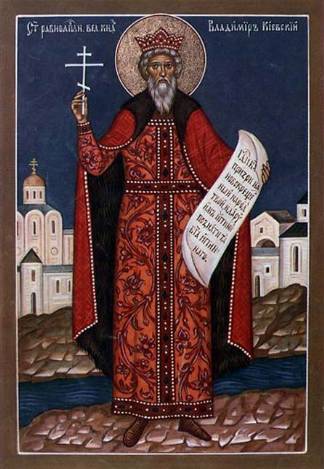
Grand Prince St. Vladimir, Equal-to-the-Apls
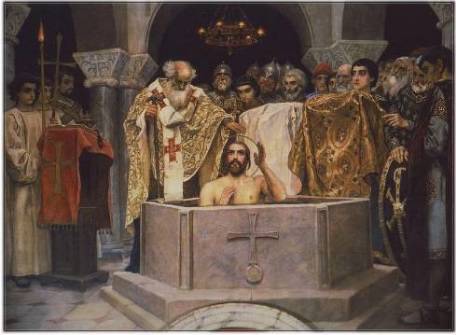
Christening of prince Vladimir. Painter Victor Vasnetsov.
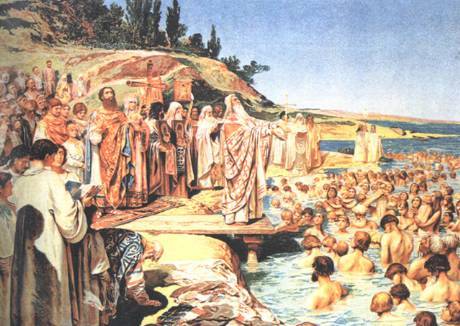
Christening of Russia. V.Vasnetsov.

Monument to prince Vladimir in Kiev, on the bank of Dnepr

Vladimir Monomah
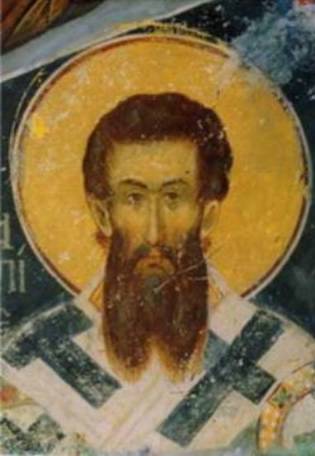
Saint Gregory Palamas. Fresco. 1371

Emperor John Kantakuzin presides the Council of 1351
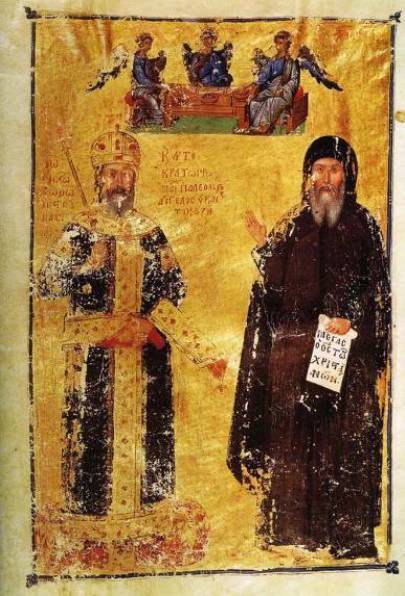
"A double icon": John Kantakuzin as the emperor and as the monk.

Sergius of Radonezh. Gold sewing. The earliest image.

Sergius with brotherhood
Lev Regelson (1990) Translated by K.Cook
The importance of the events experienced by the Russian Orthodox Church after the two revolutions of 1917 makes the few decades following then equal to centuries, so that the true meaning of what took place is hard to fathom outside the context of the whole history of Russian Christianity. What sort of traditions reposed in the church's memory at the point when the Orthodox Monarchy collapsed? What spiritual forces were maturing at this time
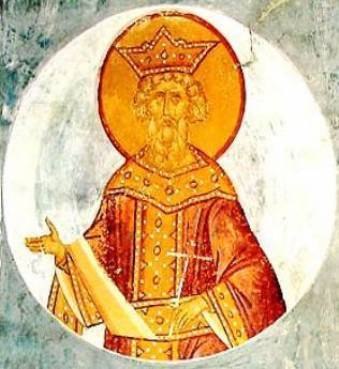 within the Church? What kind of relations did the russian Orthodox Church in her history have with the people and the state over the preceding centuries? These are the questions to which we wish to direct the reader before proceeding to a more detailed examination of the postrevolutionary events. This is particularly important now that a profound soborny conversation about Russia has begun, centuries-old layers have been shifted, there is a stocktaking of the thousand years of Russian Orthodoxy also of the most turbulent century in Russian history, and paths into the historical future are being mapped out.
within the Church? What kind of relations did the russian Orthodox Church in her history have with the people and the state over the preceding centuries? These are the questions to which we wish to direct the reader before proceeding to a more detailed examination of the postrevolutionary events. This is particularly important now that a profound soborny conversation about Russia has begun, centuries-old layers have been shifted, there is a stocktaking of the thousand years of Russian Orthodoxy also of the most turbulent century in Russian history, and paths into the historical future are being mapped out.After the relatively late emergence on the historical arena, Russia tried from the very outset, from the moment of baptism 1000 years ago, or even earlier, to determine its specific role, to find its calling among the other Christian peoples. Having received Christianity from Byzantine and Bulgarian teachers, the Russian nation introduced a maximalism and concreteness unknown since Apostolic times into what was for it a new doctrine. Full of unexpended inner strength, it longed with extraordinary spiritual daring and devotion to build the Kingdom of God on earth - in accordance with the commandments of the Gospel and those of freedom and grace.
It is no accident that Hilarion, the first Russian to become Metropolitan of Kiev, in his famous "Sermon on Law and Grace" compares the adoption of Christianity by Russia from Bizantium to the transition from the Old to the New Testament! Here on the scale of the great people the original upsurge of the Christian Church of the Apostolic age was reborn. As the eminent modern church historian A.V. Kartashev writes, Prince Vladimir strove:
"To use all the strength of state power and all the resources of the treasury to make those who had been baptized feel, as the Book of Acts says, that they were 'of one heart and of one soul', that they had 'all things common'. Before Vladimir no leader of a Christian people had ever had such a dream... He wanted to preserve and expand the universal feast and universal joy of brother-loving Christian life". A.V. Kartashev. Ocherki po istorii Russkoy Tserkvi. Paris. IMCA. 1959. Vol. I, p.125.
It is no wonder that not only vitae and chronicles were composed about Vladimir, but also folk songs and epics in which he appeared as "Vladimir the Red Sun".
Was this an "heretical" aspiration? Did it go against the Orthodox church tradition? No, it did not. There is nothing in the church's teaching winch forbids belief in the possibility of a victory over original sin already in this life, on earth.
It was, however, extremely difficult to believe in this, of course. It was not until the last few centuries of the empire that the great Byzantine Church overcame its sceptical attitude to everything earthly and accepted the doctrine of the possibility of the "deification" of human nature already in this life. Only at the height of its maturity could the Church witness resolutely that a man has been given everything necessary for such deification, for victory over sin.
Whether this possibility is realized or not depends on human intellect and will, on a person's readiness to cooperate freely with God in the matter of his own salvation. Of course, the deep-rootedness of sinful habits and, in particular, delusions of the mind makes such a task incredibly hard to solve. Baptized Russia did not realize at once how difficult this task was, but having begun to realize she did not renounce her hope. It could be said that all her tragic thousand-year history is the prolonged attempt by the people over the centuries to conquer sin and set up a kingdom of love and truth on earth.
The scale of the failures and frustrations is in keeping with the grandiose nature of the aim. But he who has sensed the deep flow of Russian history, knows in his heart that Russia will never agree to less as long as she exists!
All individual tasks, no matter now important in themselves, are only stages and steps on the way to a higher goal. And one of the main lessons of history is that this goal cannot be readied by a single nation without the participation of others.
Byzantium, winch preserved and developed the great heritage of the Church Fathers, but became too engrossed in its own pragmatic imperial interests, could not at first appreciate the profundity, sincerity and power of the great religious impulse of the newly converted Russian people.
What is more, this impulse frightened Byzantium with the prospect of Russia's spiritual and, following that, political independence, as had been the case in Abhazia in the eighth century and Bulgaria in the tenth. Energetic measures were taken to divert Russian religiosity into a safer and more familiar channel. In this "extinguishing of spirit" - the Byzantine clergy, which held hierarchical power in the Russian Church and indisputable theological authority, was largely successful. The theological arguments were supported by the force of arms, moreover: after his defeat by the Byzantine army, Yaroslav was forced to agree to the replacement of Hilarion by a Greek metropolitan and to renounce all further efforts to achieve church independence. As a "consolation" lie received the Emperor's daughter as a wife, which strengthened even more the connection of Kievan Russia with the Empire, Russia was not yet able to ensure the normal development of the Church without Byzantine leadership, of course.
The trouble was that the Byzantine Church at that time could not provide pastoral leadership for the Russian people's spiritual urge to establish the Gospel truth on earth.
To the Byzantine mind of the 11-th century the idea of the Kingdom of God on earth seemed illusory. The Byzantine vision of the depth of human sin was too sober and merciless. Hence the conviction that it was impossible to overcome original sin in the conditions of earthly life.
Hopes for the Kingdom of God were shifted to other conditions of being, "a new earth under a new heaven", which would be created only after the Last Judgement, after the sorting of the "sheep from the goats" and the total destruction of the evil forces outside man. Here we find the influence of the idealism characteristic of the Hellenes, and also echoes of the dualistic teaching of Manichaeism which, at the end of the second millennium, became extremely active throughout the whole Christian world. Manichaeism was characterized by the contrasting of spirit and matter, the preaching of asceticism as "deliverance" from the flesh, exaggeration of the force of evil and the rejection of state and church structures.
By virtue of what was originally that Manichaeist idea of the incompatibility of the divine and the earthly, the Byzantine consciousness of that age could envisage only the possibility of creating likenesses and prototypes of the Kingdom of God on earth. This spiritual symbolism flourished particularly after the defeat of the iconoclasts in the ninth century. In its creation of logical and aesthetic symbols of the Kingdom of God Byzantium had some great unsurpassed achievements, but it took her another few centuries to assimilate in practice the Old and New Testament teaching that the first "icon", the supreme and direct "image of God" was living human nature.
With regard to Bulgaria, the second source of Christian enlightenment for old Russia, it was even more than Byzantium in the grip of Manichaean preaching in the form of the "Bogomile heresy" (from the name of the priest Bogomile). The Russian chronicles called the Bogomile teachers from Bulgaria "volkhvy" (magi). The question of their influence on Russian Christian consciousness has not been fully studied, but what is know enables us to assume that this influence was persistent and longlasting. From the "magi" stretches an almost unbroken chain of heretical tradition: the "profound books" of the Strigolniks and "Judaisers", certain Old Believer and sectarian trends.
The mighty figure of Lev Tolstoy, at first sight unexpected on Russian soil, a typical "Manichean-volkhv", shows the depth and strength of this subterranean trend of Russian spirituality.
The deep-rooted feature of Russian spirituality which the Slavophiles called sobornost is connected with the hope to set up the Kingdom of God on earth. In old Russia even the feudal structure of the state, customary for Europe in that period, acquired features of Christian sobornost.
Why did Vladimir, who had united Russia around Kiev with such great difficulty and bloodshed, divide it between his twelve sons?
Could a statesman of such stature have failed to realize the danger of internecine strife or see the advantages of political unity over an unstable confederation of independent principalities?
Perhaps this was the voice of political realism speaking in him, the realization that it was impossible to hold such vast territories together under a single power?
Yet he did hold them together! One of his sons, Yaroslav the Wise, also managed to unite Russia by military force, and Prince Oleg tried to unite her in Monomakh's reign. The unity of Russia was not an Utopia in the pro-Mongol period: two political ideas, a union of principalities or a single-power empire on the Byzantine lines, clashed, one might say, in equal combat. There can be no doubt that Vladimir, who had created a new world, a new Russia based on Christianity, gave careful thought to the principles of her future state organization. A man who had brought about a change of such dimensions could not view himself as a slave of historical circumstance; more than anyone else he must have believed that history is made by people themselves - from the depth of their being in accordance with their religious con science. Vladimir chose sobornost as the principle of state structure.
Prince Vladimir's sons differed in their reactions to their father's behests. The "accursed" Svyatopolk followed the path of sin, of unrestrained, insolent self-assertion and absolute rule at any cost: the "wise" Yaroslav based his struggle for power on the demands of justice and moral laws: the "saintly" Boris and Gleb sacrificed themselves in the name of
soborny brotherly love. It was they who continued Vladimir's cause in the highest degree.
No matter how the egoism of the Russian princes (and not the princes alone!) ran riot subsequently, the ideal of Gospel sobornost, a new, absolute measure of human behavior, by which henceforward all failures and achievements, truth and falsehood, sin and saintliness were to be judged, was imprinted forever on the heart of the Russian people. The most amazing thing was that to a large extent Prince Vladimir's idea was put into practice: pre-Mongol Russian statehood gradually developed into an alliance of twelve free and flourishing principalities each with its own distinctive culture but linked to the others by strong ties of blood, language, faith and social ideal.
The Russian people's age-old love of freedom, legitimized, justified and inspired by the Christian element of sobornost, was evidently to be found in all the principalities.
Under Vladimir Monomakh the ideal of the soborny organization of Russia grew into a carefully elaborated political program. The council of Russian princes at Lubech approved Monomakh's basis ideas: fixed boundaries for each principality, the sovereignty of the prince in his "patrimony" and various form of alliance based on religious and moral principles. Voluntary agreements, vassal ones included; regular councils of princes; joint military operation when the need arose and the rituals of "sworn brotherhood" and "kissing the Cross" among the main cohesive elements. All agreements were sealed by kissing the Cross. Among the people this type of oath enjoyed great respect for many centuries - to break it was regarded as a terrible sin which led to a loss of moral authority and political influence by the guilty party. Describing this "ethical system in the sphere of politics", Academician Dmitri Likhachev writes:
"Monomakh tried to base the new political system on Christian morality, on strict fulfilment of the conditions of an agreement, on the joint solution of basic questions at meetings of princes, on mutual respect for the rights of young and old. In the final analysis the whole new system was to be based on a moral system, an ideology. This explains why Monomakh attached such importance to this ideology, nurturing writers, encouraging chronicle-writing, strengthening the church, developing the cult of Boris and Gleb, supporting the Kiev Cave monastery and even writing himself. Monomakh sought to make the new ideology and new principle a banner under which lie could lead a retinue of brother-princes". Dmitri Likhachev. The great heritage. Moscow.1980, p.149.
The bearer of the idea of compulsory autocracy as a political alternative to Monomakh's program was the aggressive Prince Oleg Svyatoslavovich, whom "The Lay of lgor's Host" calls the "Grief-famed" for the grief which he caused the Russian land. Monomakh waged a struggle against Oleg all the time, not only a military struggle, but also a spiritual and moral one, and always won.
Thus, by overcoming "the hateful strife of this world", as Sergius of Radonezh was to say later, Monomakh cultivated a communal consciousness in the Russian people.
The political structure of Russia created by him proved strong and flexible, unity and variety balanced each other creatively, the richness of local cultures did not damage the overall unity of the Russian people. A most important adhesive and unifying factor was the Church. Particularly beneficial, perhaps even decisive for this role, was the external hierarchical dependence.
The metropolitan of all Russia was subordinate to the Patriarch of Constantinople, and this was a good safeguard against attempts by princes to split the Church or subject it to their influence. The Russian princes were restrained from imperial ambitions engendering only strife and bloodshed by the religious idea of Orthodox Kingdom:
"One God in heaven and one Tsar on earth".
And this Tsar dwelt with the Patriarch in Constantinople.
The Mongol invasion was a tragedy not only for Russia, but for the whole of the Christian world. Its defeat was a direct historical consequence of the split between the Byzantine East and the Latin West. As a result of this split the Eastern Orthodox world was without a head in its hour of great tribulation.
As if by some infernal plan, just before the beginning of the Mongol aggression the Crusaders (against the will of the Pope) seized Constantinople and in place of great Byzantium created the Latin Empire of shameful memory!
There can be no doubt that only Constantinople with its many centuries of imperial experience could have organized an effective anti-Mongol strategy: sow dissension in the enemy's camp, bring the Balkans and Polovtsians, the Caucasus and Persia, in as allies and devise military tactics to combat the Mongols. At the decisive moment the Russian principalities found themselves a brotherhood without a father, a realm without a ruler, a host without a commander. If the Latin Empire had not nurtured such deep hatred between the Orthodox and Catholic peoples, Christian Europe could also have rendered aid. All this could have happened, but what actually took place was something quite different...
The history of any people, like that of the human race as a whole, is the history of its growing up: the accumulation of spiritual, cultural and political experience, the widening of its geographical and cosmic horizons, the growth of general education, the increasing complexity of social relations and, most of all, the increase in the spiritual maturity of the individual.
Retrogression and degradation take place usually in connection with external conquests - invasions by less cultured peoples, and also as a result of internal revolutions when the hierarchical structure of the social organism is violated and the lower classes of society winch are backward and not very cultured come to power. But these revolutions themselves are sometimes caused by a preceding stagnation and attempts to restrain by force the development of the lower classes which are striving to acquire the economic and cultural achievements of the higher strata. Nevertheless, in spite of temporary setbacks and sometimes the destruction of whole cultures, mankind in general is steadily growing up.
As critical moments in history Christianity is each time put to the test.
Is it capable of meeting more adult requirements? Has it the spiritual potential to respond adequately to the new, higher level of human maturity while remaining itself and not breaking with tradition?
The age of the so-called "pre-Renaissance" (the 13th and 14th centuries) was heralded by the coinciding of these "crises of growing up" in the three main centers of Christianity: Byzantium, which after the expulsion of the Crusaders became a small, ethnically homogeneous Greek state, possessed the experience of both ancient Hellenic culture and the whole history of Christianity, whose spiritual leader it had been for a whole millennium. The Byzantines were the most "adult" people in Christian mankind, and the questions which they asked the Church were the most profound and important for the future destiny of the sons of Adam.
Late Byzantium performed an unexampled spiritual-historical act: it created a new culture-historical type of human individual, to whom, we are profoundly convinced, the historical future belongs today as well.
Byzantine Orthodox personalism liberated the grown-up person from compulsory ritual and moral discipline - for free, personal communion with God. This was the same freedom that is born from truth, freedom in the Spirit of God, freedom as the revelation of the deep potential in God-created human nature. The powerful development of theology, on the one hand, and the thousand years of monastic practice of "cultivating the soul" by prayer - these were the two .unshakeable foundations of this freedom in Christ, unheard of since Apostolic times.
This is the highest maturity of the religious personality that has been reached in the whole history of mankind: deeply rooted in tradition and yet (or rather, thanks to this) unprecedentedly daring, liberated "boldly striving for God". After receiving a firm moral upbringing in the family, then an all-round humanitarian education, the young Byzantine reired for a few years to a mountain monastery where, under the guidance of experienced "elders'" he learnt "to renounce the world", "to cut off his thoughts" and to concentrate himself entirely in the "clever heart", the center of human being. Here in this center, he met God: his heart became a vessel for the "Divine Energy", a receptacle for the "Divine Light". After acquiring the habits of "synergism", co-dwelling, co-feeling, joint wishing and acting with God, the believer returned to the world. For him church theology was now personal knowledge based on the inner experience of contemplating the Divine Light and communing with God.
Theology and mystical experience are impossible without each other. Divorced from experience theology turns into rationalist philosophizing; mystical exercises without the firm guidance of Orthodox thought inevitably lead to "temptation", the mistaking of earthly, natural energies for Divine ones. On the one hand, there is rationalist scholastics, that "straw" about which the great Thomas Aquinas spoke on his death-bed; on the other, the line of mystic-heretics with no idea about the True God, which runs through the whole of Christian history. Such are the fruits of the severance of church theology from personal spiritual experience.
After he has acquired the firm habits of "clever doing" nothing can separate the believer from God: not literary occupations, nor married life, nor political and economic activity. That which in Old Testament times was the possession of a mere handful, and in early Christianity of small closed communities, was now becoming a hard, but attainable aim for the whole people. All the earthly world, all the facets of human being were open to gradual synergetic mastery and cultivation.
The highest spiritual striving was that this path should be offered to all: to monks and laymen, chaste and married, educated and simple-minded, princes and peasants, soldiers and tradesman. The whole country was covered with a network of theological schools. Anyone who liked could receive an accurate and profound answer to all his questions. In many monasteries there were elders who helped to correct mistakes by the practice of prayer. And all this was under the firm protection and patronage of the Imperial power and the church hierarchy: the Emperor and the Patriarch were also prayers and theologians. It is no accident that the height of Byzantine spirituality (the middle of the 14th century) was heralded by the collaboration of the three great figures of the age: the Theologian Gregory Palamas, the Emperor John Cantacuzenus and the Patriarch Philotheus Kokkinus (see, for example: G.M.Prokhorov. "Povest o Mitaye. Rus i Vizantiya v epokhy Kulikovskoy bitvy". Leningrad, 1978).
Of course, all this took place in the constant struggle against sin, heresy and military danger. But sinful habits were gradually ousted by the skills of synergism, and in free polemics with its "heretical" opponents Orthodox theology acquired increasing richness and depth. The only way to combat such Christianity was by direct and downright force: the Turkish conquest interrupted this great spiritual movement which had just begun to realize its unlimited inner potential. This supreme elite of Christian mankind was still too small in number and had gone too far ahead in its spiritual impulse, so that it was not understood by its children and brothers who had the power to save it from physical destruction. If they had understood everything could have been different...
The side branch of Byzantine humanism in the person of this eminent philosophers and politicians Barlaam and Akyndynos was defeated in the course of theological disputes over many years. The skepticism and rationalism of these thinkers was unable to withstand the powerful spiritual and theological witness of Palamism. after John Cantacuzenus' victory in 1347 in the struggle for the throne, Barlaam and Akyndynos, supporters of the Union with Rome who were involved in the political struggle, emigrated to Italy. There too these "outsiders of Byzantinism", theologically rooted by Gregory Palamas and rejected by the Church and the people, became the forefathers of the Italian Renaissance!..
They too were humanists and they too were looking for solution to the question about the correlation of individual and collective human will with the will of God. But their solution was man's separation, independence and emancipation. They saw the doctrine of Divine Energies as a new paganism and the practice of synergism as spiritual slavery and imitation of non-Christian Oriental mysticism.
The essence of their mistake was that they did not believe in the possibility of man communing directly with God, in man's co-creativity with God, in the "communicating" to man of the Divine essence in the form of energy. They to strove to liberate grown-up man from the bans and restrictions necessary only in the age of "childhood". But, not believing God totally, they did not find, and could not find, any other path except the partial "liberation" of man from God as well, whereas Palamism liberated man for God.
The inevitable result was that beside the organic, full-blooded freedom of "synergetic humanism", "Renaissance" freedom seemed truncated, relative and more negative than positive. Not wishing to renounce God entirely (this happened later) the European Christian humanists restricted freedom of thought, feeling and creativity to formal loyalty to once manifested Divine revelations, disciplinarian observance of the moral commandments and rationalist interpretations of Holy Tradition, one might say everything that was left to "fallen Adam" after he had been expelled from paradise.
The teaching of European humanism is the ideological objectivisation of original sin, the recognition of its inevitability and acceptance of the need for it. One could "taste" of the tree of knowledge only by deceiving the Creator. And this became the basic culture of the Renaissance! The Renaissance of what? Ancient Hellenic humanism, Olympic paganism: these reminiscences of Byzantium's childhood became a revelation for mediaeval Christian (and not long before that barbarian) Italy.
Yet another manifestation of the indisputable moral superiority of the supporters of synergism over their opponents: after the political victory of 1347, when the Palamists occupied key posts in the state, they made it possible for free polemics to continue and did not have recourse to any external coercion with respect to those whom they considered wrong. Meanwhile, however, in the period of the short-lived victory of the Latin anti-Palamist party (1341-1347) the followers of synergism were subjected to the cruellest repressions!
The tolerance of heretics inherited in Russia by the "Non-Possesors" and unprecedented in the Middle Ages is a sign of great inner strength, spiritual maturity and true freedom in Christ. The opponents of synergism made full use of the freedom given them.
The famous scholar Nicephorus Gregoras continued the anti-Palamist polemic, basing himself on the highest achievement of pre-Christian Hellenism - Neoplatonism. Superficially reminiscent of the Hesychast "clever doing", the gnostic mysticism of the Neoplatonists had to do only with refined earthly energies mistakenly taken for Divine ones. The Neoplatonic ecstasies could tear man away from the earth and carry him into the mentally-spiritual heights of the earthly cosmos, but the energies transmitted in these ecstasies were incapable of revealing and transforming the whole fullness of human being.
The Hesychasts (from the Greek word “hesychia” meaning “silence”; this name became used of monks who practiced “mind and heart” prayer) - and herein lies their immense superiority over the Neoplatonists - sought not only to spiritualize the psyche, but also to deify the material body which they did not contrast with the soul. This was a step towards victory over death, which is the separation of soul and body. It was a restoration of the wholeness of man, of that "chastity" about which the Apostles and Holy Fathers Taught.
Palamism was defended against Nicephorus Gregorus by Philotheus Kokkinus. Contrary to Gregorus' assertion that mystical experience was of an elitist nature and accessible only to a chosen few, Patriarch Philotheus insisted that the possibility of man's personal communion with God "should not be ignored, as some assume, but preached, and everyone should be encouraged to become participants in this Divine Light". Philotheus attached crucial importance to this, saying that it was "the matter on which the salvation of Christians depended" and, following the behests of the great prayers Gregory of Sinai and Nicholas Cabasilas, urged monks who had up till then "fled the world" to now turn "with preaching and instruction to the world with the aim of saving it". As Nicholas Cabasilas taught, given constant communion with God in mindful prayer "one can make use of art without harm, and there is no obstacle to engaging in anything, and the general can command his troops, and the farmer can till the soil, and the ruler govern the land.
It was from these men that the great Russian zealots of the 14th and 15th century, from Sergius of Radonezh to Nilus of Sora, learnt! Amazed and overjoyed that such a "great enlightener of minds" had appeared in distant Russia, Patriarch Philotheus himself sent a whole embassy to Sergius to ask him to establish community life monasticism.
"We have heard of your virtuous life, - Philotheus wrote to Sergius, - and greatly approve of it and thank God. But there is one thing that you lack - community life. You know, Venerable Sergius, that David the Patriarch, who embraced all in his wisdom, praises community life: "It is good and fine for brethren to live together".
This authoritative counsel from the Patriarch confronted Sergius with an important and most difficult question. The communal living based on discipline and obedience was ordinary practice: not only in monasteries, but also in the army, in any school or in a large patriarchal family. In monasteries it was usually regarded as the easier, initial stage of spiritual growth. The higher stages were achieved in solitude, in the "schema". When communal living was suggested to Sergius and his followers, they had already been living in the schema for about twenty-five years. They were not new monks, but mature experienced zealots who lived in the same place but separately, helping and advising one another, but each according to his own order and understanding received from God, according to the "grace given unto him". For monks such as these a change to community life rule could mean a fall from truth, a going back. It would lead to the loss of blessed gifts, the violation of personal communion with God, the very communion for the sake of which the person had renounced the world. The question of monastic community life became for Sergius a question of the nature of human life in general.
Could the human individual grow further than a certain point under community life rule? Could a person co-create himself not only together with God, but together with his fellow men?
The solution found by Sergius and his brothers became, the great contribution of the Russian spirit to the treasury of Orthodoxy. The theological formula of this solution was profound and simple:
"Unity in the image of the Holy Trinity".
In the Palamite tradition this was a step of immense importance. Of course, in the Byzantine monasteries the pupils, gathered round an elder, formed a spiritual community which usually survived even after they returned to the world. But this was only a scholarly fraternity, although it later developed into cooperation in joint affairs. But the main thing, the actual "clever doing", the actual entry into communion with God, remained essentially an individual affair. Community life as growing like God, brotherhood as a way of uniting with God, human sobornost as a Divine image - this practice had only one precedent in church tradition: the Apostolic community. This communal life was the answer to Jesus Christ's prayer to the Father:
"As Thou, Father, art in Me, and I in Thee, that they also may be one in us: that the world may believe that Thou hast sent me." Jn. 17: 21.

--------------------------------------------------------------------------------------------------------------
